Department of
Future state, future skills
Australia Space Industry Strategy 2024-30
Accelerating STEM skills for Western Australia
October 2024
State STEM skills strategy: Mission update 2024-2029



Department of
Australia Space Industry Strategy 2024-30
Accelerating STEM skills for Western Australia
October 2024
State STEM skills strategy: Mission update 2024-2029


The Department of Jobs, Tourism, Science and Innovation (JTSI) acknowledges the Traditional Custodians throughout Western Australia and their continuing connection to the land, waters and community. We pay our respects to all members of Aboriginal and Torres Strait Islander communities and their cultures, and to Elders past and present.

Disclaimer
The information is provided in good faith and believed to be accurate and current at the time of publication, but this cannot be guaranteed. The State of Western Australia makes no representation, warranty or claim of any kind (express or implied) about the completeness, accuracy, reliability or suitability, with respect to the information. The reader is solely responsible for making their own assessment of the information and should make and rely on their own enquires, research and judgements in making decisions affecting their own or any other persons’ interest.
To the fullest extent permitted by law, the State of Western Australia, its officers, employees, agents and representatives, shall in no way be liable, in negligence or howsoever, for any loss, damage, cost or expenses (regardless of whether the loss is direct, indirect or consequential) caused, sustained or incurred by anyone using or relying on the information, even if such information is or turns out to be wrong, incomplete, out of date or misleading.
Subject: Boab Tree, near Derby
Credit: Tourism Western Australia
Western Australia is home to significant civil and defence space infrastructure, and a thriving ecosystem of more than 130 international and Australian organisations engaged in space-related services.
The State’s space history spans tens of thousands of years, as Aboriginal people used astronomical phenomena to inform behaviour, navigation and social structures. In recent times, Western Australia has played key roles supporting global space operations; including NASA’s Apollo program in the 1960s, and Intuitive Machines’ IM-1 mission in early 2024 –marking the United States’ first return to the lunar surface since 1972 and the first successful commercial lunar surface mission.
The Cook Government has identified space industries as a priority sector under the Diversify WA Economic Development Framework – aiming to diversify our economy and create new jobs.
Growing the space sector will also support Western Australia to benefit from space technology, data and services - leading to innovations that improve environmental and community outcomes, boost productivity, and improve our everyday lives. More than $1 billion has been invested or committed to Western Australia’s space sector since 2018.
The Space Industry Strategy sets out a framework for Western Australia to build on our global recognition as an Indo-Pacific space hub and secure Western Australia as the place for space.
Hon Stephen Dawson MLC Minister for Science

For more than 60,000 years Western Australian Aboriginal people have used the night sky for navigation, to predict weather, for information about food sources, and to catalogue and tell stories.
Today, space plays an equally important role in Western Australia.
Western Australia is involved in a diverse range of space activities – providing critical support for international space agencies and commercial space missions, building the world’s largest radio telescope and transferring our world-leading remote operations technologies from the resources sector to space missions.
Western Australia is also at the forefront of technology transfer between space and terrestrial sectors to improve productivity, safety and socioeconomic outcomes for our economy and community. Our State’s space industry is underpinned by a highly skilled workforce, a world-class space science ecosystem, a thriving community of space STEM outreach groups and supported by innovation hubs and common use infrastructure. This Strategy will enable Western Australia to build upon our space capabilities and comparative advantages to make the State a global hub for space mission operations, exploration and technology transfer.
Professor Peter Klinken AC Chief Scientist of Western Australia
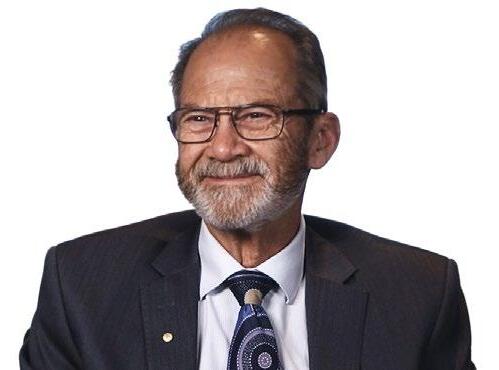
Space technologies, data and services are integral to our daily lives; from digital communications, GPS positioning services, remote sensing (Earth observation, EO), and the many technologies developed that are now commonly used; ranging from smartphone cameras, cordless power tools, computed tomography (CT) scanners and Cochlear implants. In 2023, the global space economy was worth more than US$630 billion.
Space technologies and activities offer a multitude of benefits for life on Earth. They drive innovation and provide critical services that support various industries such as agriculture, resources, manufacturing, policing and government services. Space exploration expands scientific knowledge, leading to discoveries with applications on Earth, including advancements in new materials, physics, and medicine.
Satellite data also plays a crucial role in environmental monitoring and mitigating the impacts of climate change by providing data on land and sea surface temperatures, tracking deforestation and CO2 emissions. Additionally, satellite data and services are critical for emergency operations, management, response and prevention, as well as for remote connectivity. Global satellite navigation systems, such as GPS enhance transportation, logistics, and emergency services.
Space exploration inspires curiosity in STEM (science, technology, engineering, and mathematics) education, motivating future generations of scientists, technicians and engineers. Lastly, space exploration fosters international collaboration, promoting peace and mutual understanding among nations while collectively addressing global challenges.
Moreover, investment in this sector supports highly skilled jobs, energy technology advancements with practical applications, creates business opportunities that feed back into the economy, and contributes to a more diverse and sustainable economy by generating jobs and supporting economic growth.
Overall, the benefits of space technologies and exploration enhance our quality-of-life, drive cross-sector technological progress and foster global co-operation for a brighter future on Earth.
Humanity and Equality: The United Nations has recognised the important role of space services, applications, and technologies in supporting the achievement of its 17 Sustainable Development Goals, aimed at ending poverty, protecting the planet, and ensuring prosperity for all by 2030.
The importance of space-based services is also reinforced by the United Nations Office for Outer Space Affairs’ Access to Space for All initiative, which focuses on enabling communities from all over the world to use and benefit from space technologies and applications through international cooperation.
Communication and connectivity: Satellites provide global communication connectivity through radio, telephone, television and internet services.
Disaster management and response: Space-based Earth observation satellites provide real-time data on weather, bushfires, and natural disasters, which is vital for early warning, disaster preparedness, and emergency response.
Environmental monitoring and sustainability: Earth observation satellites provide crucial data for monitoring climate change, quantifying greenhouse gas emissions, tracking deforestation, and managing natural resources. This vital information empowers organisations to implement sustainable practices and tackle pressing environmental challenges.
Navigation and precision agriculture: The satellite enabled Global Positioning System provides precise positioning data for various applications. This is crucial for efficient transportation, logistics and precision agriculture techniques.
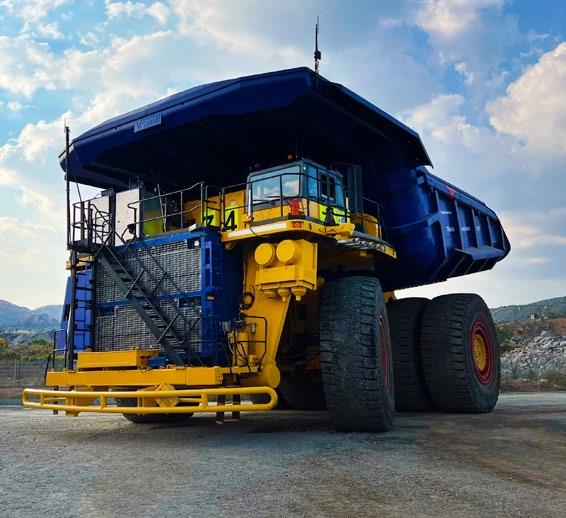
First Mode’s hybrid fuel cell and battery powerplant Ultra Class Haul Truck
Space technologies also accelerate terrestrial industry innovation, for example:
Energy technologies: Development of more efficient power production and storage systems for space missions (including solar and battery technology and use of green fuels) can lead to enhancements in renewable energy technology and utilisation on Earth.
Material science: The harsh environment of space requires the development of new, high-performance materials (including miniaturisation, lower power demand, low weight) with applications in various fields like resources, aerospace, construction, and medicine.
Robotics and automation: Advanced robotics for space exploration will contribute to the development of more sophisticated robots for various applications on Earth, including agriculture, resources, manufacturing, healthcare, and disaster response.
The Western Australian Government’s Diversify WA framework identifies space industries as a key area where the State has competitive advantage with significant growth opportunities.
This is built on further in Future State: Accelerating Diversify WA (Future State), which highlights space and cross-sector technologies as a strategic investment opportunity to promote Western Australia’s economic diversification, create jobs, attract investment and foster innovation.
Future State sets a goal for Western Australia to become ‘a global leader in the manufacture, utilisation and maintenance of space and cross-sector technologies’ by 2035.
Committed to achieving net zero emissions by 2050, the Western Australian
Government is taking a range of bold actions to decarbonise the economy and make the transition to clean energy.
The journey towards net zero emissions will be driven by innovative technologies, including those from the space industries. Technology transfer from the space sector to the resources sector will directly support these commitments through the development of new technologies aimed at decarbonisation and electrification, whilst supporting the three circular economy principles: reducing waste and pollution, enhancing resource utilisation and regenerating natural systems1 .
This Strategy will support and is complemented by a range of economy wide and industry-specific Western Australian Government strategies (see Figure 2, right).
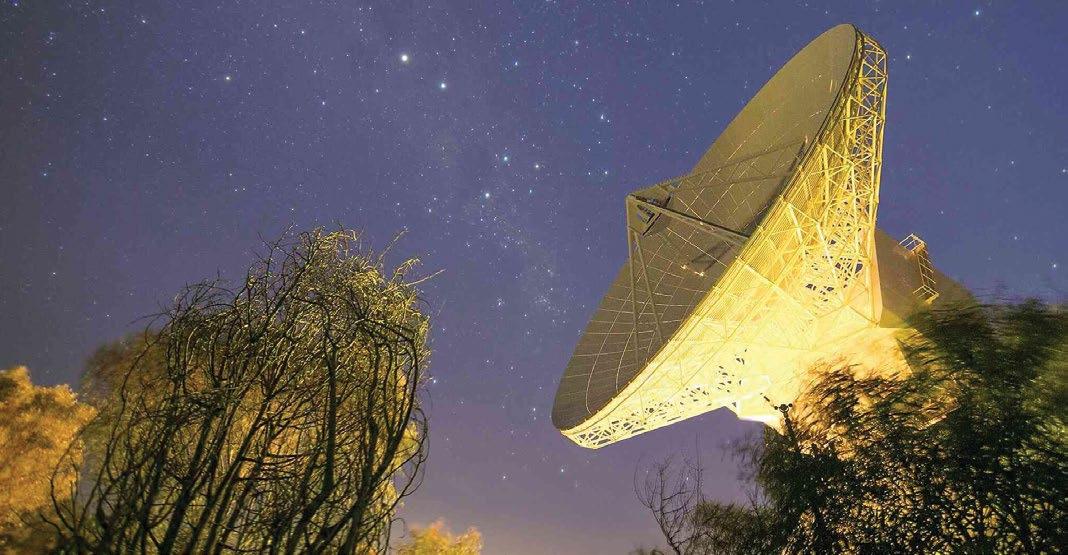
Subject: ESA’s DS-1 Deep Space Tracking Station near New Norcia Credit: European Space Agency (ESA)
1 Taylor L, 2020. Three core principles of the circular economy
WA has a growing, vibrant and sustainable space ecosystem Science, technology and innovation
WA space operations, exploration and technology transfer capability increases
WA attracts significant investment to support the space ecosystem WA researchers, industries and government increase utilisation of local space services, data and technology
The WA space ecosystem supports STEM education, promotion and training The WA community’s awareness on the value of space is enhanced
WA Innovation Strategy
WA’s 10-year Science and Technology Plan Investment and Trade Plan 2022-24 Supporting continuous improvement in ESG outcomes for WA
WA Digitally Evolved
WA Defence and Defence Industries Strategic Plan
Policy
The global space economy is forecast to reach US$1.8 trillion by 2035, up from US$630 billion in 2023 and growing at an average of 9% per annum2. Reshaping the future of the space sector are advances in technology, reduced launch costs, the development of new space systems, increased private sector investment and rising demand for space data, services and technology3.
In 2021, the global space sector employed around 400,000, with forecasts predicting an increase to 1.5 million jobs by 20404,5. Space technologies have yielded a plethora of applications on Earth - NASA calculates its return-on-investment in space technologies is up to 14:1 long-term. Since 2000, the number of space agencies has grown from 40 to more than 75 today2 .
The Indo-Pacific region is a global space powerhouse, with 17 national space agencies and significant commercial space activity. In 2023, China (US$14 billion), Japan (US$5 billion), and India (US$2 billion) ranked among the top 10 in global government spending on space programs.
Established in 2018, the Australian Space Agency (ASA) contributes to Australia’s wellbeing and prosperity through the responsible use of space. Australia’s space sector is growing rapidly, with ASA calculating that investment in Australia’s space sector between 2017 and 2021 was more than $2.88 billion, including $917 million inbound investment. In 2023, more than 600 space companies were operating in Australia.
Western Australia has more than 60 years’ experience in the space industry, benefiting from its geographic location, dry environmental conditions, radio quiet zones and clear skies. These advantages have made Western Australia an attractive location for major space projects since the 1950s. From 1961 to 1975, ground stations in the State played key roles in NASA’s Mercury, Gemini and Apollo missions. Today, Western Australia is involved in a range of space operations, hosts significant space infrastructure for both civil and defence applications and is home to more than 130 international and Australian organisations operating space and spacerelated services. Key areas of activity and capability include ground-based satellite and deep space communications (more than 30 organisations with ground stations in the State); space situational awareness (SSA; more than 20 organisations with SSA operations in Western Australia); EO; data processing and analysis; and world-leading remote operations, automation and robotics. Emerging capabilities include space mission operations, space optical communications, satellite development and launch.
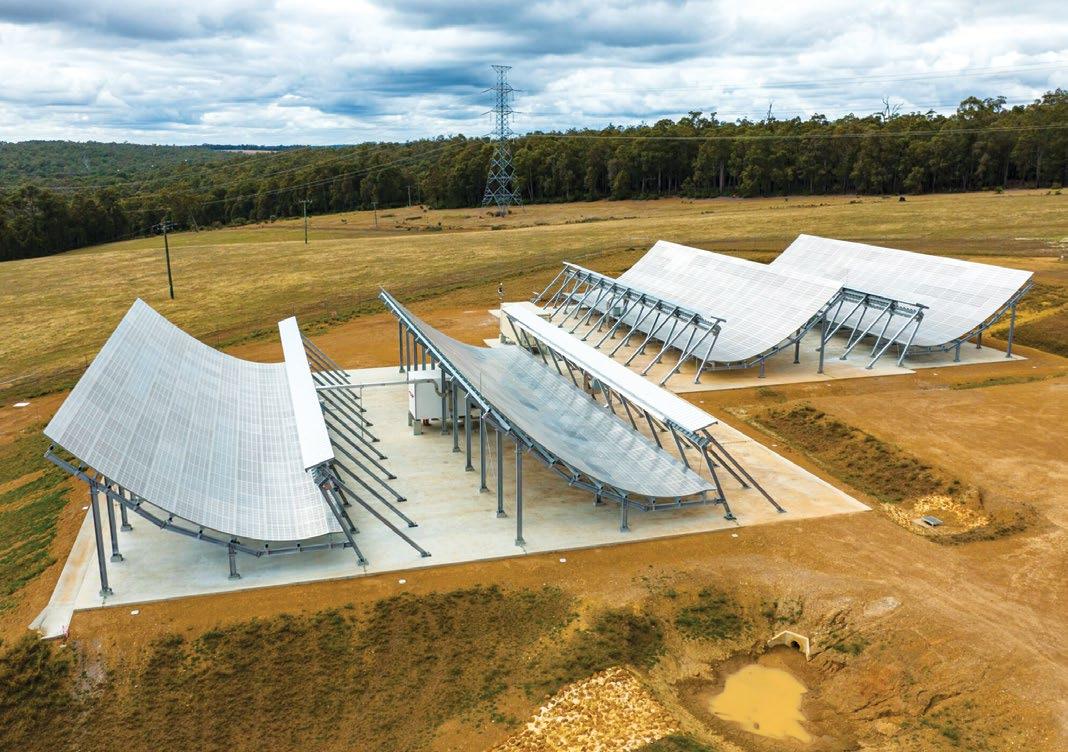
With a diverse and strong economy, Western Australia also has a significant market for space technology, services and data within its mining, oil and gas, agriculture, health, defence, energy, and maritime industry sectors. There is also significant technology transfer between the space sector and the State’s terrestrial industry sectors, leveraging space technology and services to drive innovation on Earth and adapting terrestrial technology for space.
Since 2018 there has been more than $1.2 billion invested in or committed to Western Australia’s space sector, including more than $250 million private investment. In the same period, the number of space companies in the State has doubled. Western Australian organisations also have strong collaborations with international space and defence companies, ASA and international space agencies including NASA, the European Space Agency (ESA) and Japan Aerospace Exploration Agency (JAXA).
2 World Economic Forum, 2024. Space: The $1.8 Trillion Opportunity for Global Economic Growth.
3 Deloitte, 2022. Future of the Space Economy.
4 Manhattan Institute, n.d. The Growth of the Space Economy.
5 US Chamber of Commerce, 2022. Space Economy: 4 Trends to Watch in 2022.

Australian Automation and Robotics Precinct
Space Science Education Centre, Joseph Banks Secondary College
WA Austcyber Innovation Hub
Edith Cowan University Security Research Institute
Perth International Telecommunications Centre
Inmarsat
Telstra
Scitech
WA Museum Boola Bardip CERI
CORE Innovation Hub
DUG Technology
Australian Remote Operations for Space and Earth (AROSE) consortium
Space Automation, AI and Robotics Control Complex
The University of Western Australia International Space Centre
Crawley Perth CBD
Optus Earth Station
Speedcast ground station
Perth Landing Pad –Spacecubed Bentley Kensington
Western Australian
International Centre for Radio Astronomy Research
ERDi Testlab
WA Satellite Technology and Applications
Consortium
Earth Station
CSIRO
Australian Science Operations Centre
Australian SKA Regional Centre
Australian Science Processing Centre
Space and Astronomy
Pawsey Supercomputing Research Centre
Perth Observatory
Curtin University
GNSS Satellite Positioning and Navigation Group
Remote Sensing and Satellite Research Group
Space Science and Technology Centre
Curtin Institute for Radio Astronomy
Data Science Innovation Hub
Innovation Central
Australian Space Data Analysis Facility
Key
Education and public outreach
Defence Facilities, organisations, precincts
Ground Stations
Launch and returns
Regional calibration sites
Research centres
Start-up and SME innovation hubs
Education and public outreach
Facilities, organisations, precincts
Regional calibration sites
Research centres

Launch and returns
Regional calibration sites
Ground Stations Research centres
Start-up and SME innovation hubs
Radio astronomy telescopes, research centres and supporting infrastructure Supporting HPC infrastructure and cyber security
Start-up and SME innovation hubs
Radio astronomy telescopes, research centres and supporting infrastructure Supporting HPC infrastructure and cyber security
research centres and supporting infrastructure Supporting HPC infrastructure and cyber security
Telescopes; Position, Navigation and Timing (PNT); and space situational awareness (SSA)
*Under development; **Proposed
Telescopes; Position, Navigation and Timing (PNT); and space situational awareness (SSA)
*Under development; **Proposed
Telescopes; Position, Navigation and Timing (PNT); and space situational awareness (SSA)
*Under development; **Proposed
Christmas Island - Space Angel **
Cocos and Keeling Islands Indian Space Research Organisation*
Across WA Geoscience Australia Continuously Operating Reference Stations (PNT)
Distributed nationally Desert Fireball Network, Curtin University





































COMSPOC* and ThothX LLC
NBN ground station
ExoAnalytic








Harold E Holt Communications’ Station (Space Surveillance Telescope, C-Band Space Surveillance Radar System)


Carnarvon Space and Technology Museum and OTC dish
Earthfence Deep Space Radar






UWA Space Surveillance Hub:




Gravity Discovery Centre and Observatory



CSIRO calibration site










































Learmonth Solar Observatory EOS (SSA laser-optical telescope)
Carnarvon Australian Square Kilometre Array Pathfinder Murchison Widefield Array Square Kilometre Array*
Kojarena
Mingenew Space Precinct Gingin
European Space Agency (Deep Space Network)
Starlink Starlink Spacecubed Geraldton
SEE PERTH REGION INSET
NBN ground station


LeoLabs, West Australian Space Radar (SSA)
Starlink
Satellite Station
ExoAnalytic Solutions (SSA telescopes)
Starlink Cingulan Space


















Inmarsat Global XpressNetwork






DUG Technology*




MRO Support Facility Square Kilometre Array Engineering Operations Centre Murchison
Orion Satellite Systems NBN ground station











Australian Defence Satellite Communications Station Starsite
Mingenew Space Precinct CNES DORIS ground station operated by Geoscience Australia (PNT)
NASA MOBLAS 5 Satellite Laser ranging facility (PNT)
Swedish Space Corporation, Western Australia Space Centre (SSA)
University of Tasmania Very Long Baseline Interferometry (PNT)
Australian Maritime Safety Authority MEOSAR satellite ground station
Capricorn Space Precinct – WA Teleport: Goonhilly Earth Station*

Australia Space Industry Strategy
This Strategy’s aim is to provide a framework of how the Western Australian Government will support the growth of Western Australia’s space industry sector to enhance economic diversification and jobs growth.
Vision – Western Australia is a globally recognised Indo-Pacific space hub.
Mission – To drive the growth of Western Australia’s space ecosystem.
The Strategy sets the following goals to realise the Vision:
1. Western Australia has a growing, vibrant and sustainable space ecosystem – with research, government and industry organisations working together to maximise the benefit from the sector to the State.
2. Western Australian space operations, exploration and technology transfer capability increases – with enhanced job opportunities in the sector for Western Australians.
3. Western Australia attracts significant investment to support the space ecosystem – with local, national and international investment supporting sector growth.
4. Western Australian researchers, industries and government increase utilisation of local space services, data and technology – to enhance productivity, jobs growth, economic diversification and decarbonisation.
5. The Western Australia space ecosystem supports STEM education, promotion and training – enhancing the growth of a local skilled workforce to support space and terrestrial industry growth.
6. The Western Australian community’s awareness on the value of space is enhanced – with local space activities being supported and celebrated within the State.
This strategy identifies six space industry strengths and opportunities that will guide the Western Australian Government’s activities to position the State as a globally recognised Indo-Pacific space hub. This includes leveraging space technology, data and services to improve environmental and community outcomes, boost economic productivity, and improve the lives of all Western Australians.
Western Australia is transferring its world leading remote operations capabilities to space mission operations and exploration.
Space mission operations involve the planning, management and execution of missions in space. Western Australia is the world-leader in remote mission operations for terrestrial industries with significant activity in the State at the intersection of space and terrestrial mission operations, providing opportunities for technology and knowledge transfer between the sectors.
While most space mission operations facilities are in the Northern Hemisphere, there is a growing demand and opportunity for Southern Hemisphere facilities to support global coverage and provide 24/7 oversight for missions.
Space exploration is experiencing the greatest market growth in the global space economy, with Western Australia having significant capability in this area, ranging from the use of telescopes for astronomy, to the physical exploration of space by uncrewed robotic spacecraft such as probes and rovers.
Western Australia is an ideal location for space communication, tracking and launch
activities, offering a range of advantages and optimal environmental conditions.
Western Australia with its clear skies, large arid areas, minimal radio interference, and location around 120 degrees apart in longitude to Western Europe/UK and North America is a world-class location for hosting space ground infrastructure. The State already hosts dozens of national and international facilities that support the global coverage of space assets; space communication; space situational awareness; and positioning, navigation, and timing.
In addition, Western Australia’s sparse population, vast coastline, and minimal air traffic also provide advantages for space launch and return activities.
Western Australia has growing space systems and hardware capability.
Western Australia has growing capabilities in the design, manufacture and testing of space systems and hardware, including satellite communication technologies, satellites and payloads, and sensors. Western Australian organisations are currently building spacecraft and astronomy hardware, manufacturing and sustaining satellite communication technology as well as developing lunar rovers.
Western Australia has significant infrastructure and capability in space data processing and analytics, with increasing demand for space-enabled services and data.
Space-enabled services use space data and technologies to enhance decision-making, productivity, and socio-economic development across sectors.
Western Australia, with its vast land area and coastline, sparse population, and remote mining, energy and agriculture activities, relies on space-enabled services and data for daily operations and communications. Future demand is expected to grow to enhance connectivity, digitisation, innovation, and sustainability.
Western Australia has significant computing infrastructure and capability in data science, analytics, and cybersecurity to support space data analytics and operations.
East Metropolitan Health Service’s HIVE – Health in a Virtual Environment is Western Australia’s first inpatient remote monitoring service. The innovative service dramatically transforms how the State cares for patients.
The HIVE Team is based in a central Command Centre and provides 24/7 continuous monitoring of vulnerable patients at multiple hospital sites across Western Australia. From the Command Centre, the HIVE clinicians monitor patients’ vital signs, such as heart rate, blood pressure and oxygen levels.
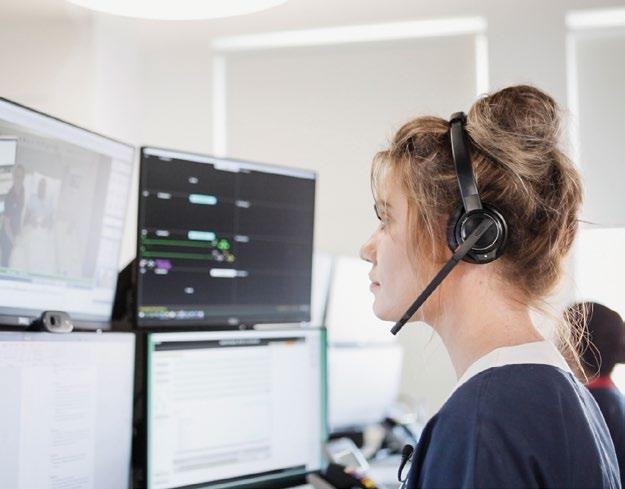
East Metropolitan Health Service’s Health in a Virtual Environment (HIVE)
The service is enabled by an AI platform that detects the earliest signs of clinical deterioration. When an alert is generated, HIVE clinicians use a two-way audio-visual system to collaborate with the patient and clinicians on the ward to deliver care.
Satellite communication is essential for the delivery of the service as it provides realtime audio-visual connection and data delivery between the patient and HIVE.
Western Australia is at the forefront of technology transfer between space and terrestrial industries.
Many new technologies developed for space exploration have applications on Earth as commercial products and services. For example, NASA has identified more than 2,000 of its space technologies used in commercial products such as energy storage batteries, temperature-regulating clothing, scratch-resistant lenses, cordless power tools, and programmable implantable medication systems6.
Western Australia is at the forefront of technology transfer between terrestrial and space industry sectors. Key examples include:
AVI – has transferred its expertise in hardened communications systems from the resources and defence sectors to radio astronomy and satellite hardware.
Western Australia is at the forefront of technology transfer between space and terrestrial industry sectors, leveraging space technology and systems engineering to solve challenges on Earth and transferring terrestrial technology for space applications. Key areas include remote operations, automation, AI, and robotics. The annual Indo-Pacific Space and Earth Conference (IPSEC) in Perth encourages technology transfer between space and terrestrial industry sectors.

NASA Valkyrie Robonaut testing at Woodside Energy Perth
The International Centre for Radio Astronomy Research has spun out radio astronomy technology developed for the SKA project for passive SSA and optical satellite communications.
Fugro-SpAARC is transferring its marine remote operations expertise to space to support a range of space missions.
First Mode – has pivoted from its space systems engineering origins to building clean energy solutions for heavy industry.
OffWorld – has pivoted its robot swarm technology from off-Earth mining to terrestrial mining, processing, manufacturing, and construction.
Transparent Earth Geophysics (TEG) – TEG with Advanced Navigation have transferred their capability in terrestrial gravimetry (used for resources prospecting) to autonomous Moon navigation systems.
Woodside Energy Group has partnered with NASA to test NASA’s Valkyrie humanoid system in the terrestrial resources sector.
6 NASA, 2024. NASA Technology Transfer Program.
Western Australia has significant spacerelated tertiary research, training, and education capabilities, supporting the growth of the space ecosystem.
The space industry is a multidisciplinary domain that requires a broad and diverse range of skill sets to help grow the space ecosystem. ASA has identified more than 30 space careers across five broad areas including communications, project
management and business support; engineers; IT, data and software specialists; scientists; and technicians.
Western Australia has significant tertiary research, training and education capability in the space sector provided by Curtin University, CSIRO, Edith Cowan University (ECU) and The University of Western Australia (UWA). Joseph Banks Secondary College Space Science Education Centre provides space education opportunities for school students.
Curtin University’s Space Science and Technology Centre (SSTC) is home to the largest planetary research group in the Southern Hemisphere. Key strengths include SSA, space engineering (CubeSats) and machine learning in planetary geology. Curtin University’s Remote Sensing and Satellite Research Group undertakes research related to calibration and validation of satellite remote sensing observations. Curtin University’s GNSS Satellite Positioning and Navigation Group develops theory, models, and methods to provide the high accuracy and high-integrity requirements for future GNSSs. Curtin University annually graduates dozens of science and engineering students in spacecraft design, space missions, EO and GNSS. SSTC also runs a major outreach program for high school students to design and prototype satellite payloads (BinarX).
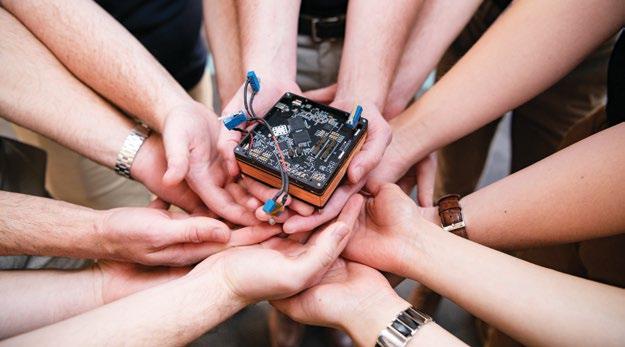
Subject: Curtin SSTC researchers hold the BINAR-1 CubeSat
Credit: Curtin University Space Science and Technology Centre
ECU is currently establishing new space research and training capability with an emphasis on space exploration, satellite technology and SSA.
UWA’s International Space Centre (ISC) combines leading space science, research and teaching capabilities, with the mission of advancing our ability to operate from space and enabling the development of innovative technology to enhance and sustain life on Earth and beyond. ISC is a multi-disciplinary team that includes more than 12 research nodes and 150 researchers. ISC specialises in (space) optical communications, SSA, batteries, propulsion systems, health, agriculture, engineering, information technology, and social studies. UWA graduates dozens of science and engineering students trained in these space sectors. UWA also runs a Space Boot Camp for Year 9 and 10 students. UWA also hosts the Defence and Security Institute with expertise in space, AI, automation and quantum technologies.
To achieve the six Strategic Goals, the Western Australian Government is taking action in six priority areas. A separate, but linked, Action Plan will detail an initial agenda under each action area. The Action Plan will remain dynamic with initiatives added to as the need and opportunity arise.
Promote Western Australia’s space industry sector capability locally, nationally and internationally.
The Western Australian Government will continue to promote the State’s space industry sector capability both internationally and domestically through various initiatives. These efforts include promoting Western Australian space industry capability and capacity nationally and internationally through ASA, leveraging the Western Australian Government International Trade Office network, supporting Western Australian space industry involvement in international delegations, and welcoming national and international space industry delegations to the region. Through Invest and Trade WA, the Government operates a global network of investment and trade offices in the State’s key trading regions which can be leveraged to attract international investment and facilitate knowledge sharing and trade opportunities across the space sector.
Additionally, the Western Australian Government will promote the State’s space industry capabilities at national and international conferences and events, such as IPSEC, and directly to space agencies, governments, industry, and research organisations worldwide. Advocacy for the adoption of space data, services, and technology by Western Australian Government agencies and industry is also a priority.
Furthermore, recognition programs like the Premier’s Science Awards and the Western Australian Innovators of the Year can help to highlight and support the industry’s achievements and innovations.
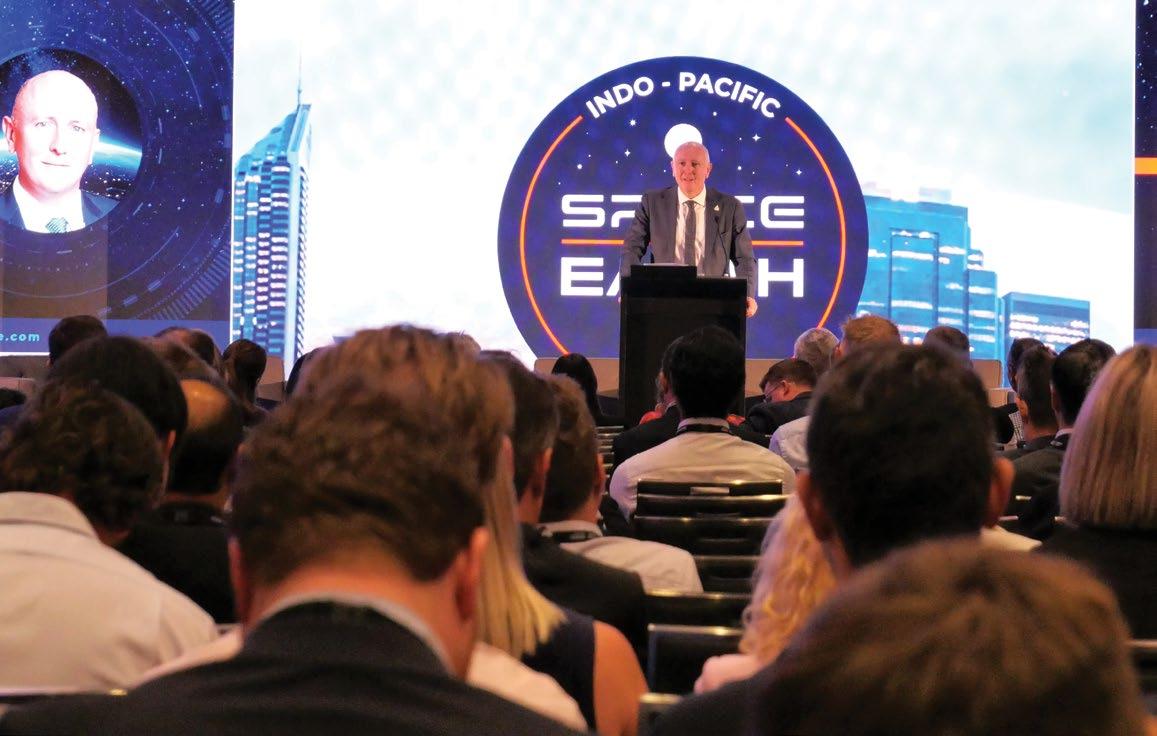
The Western Australian Government was the Principal Partner of the inaugural 2023 Indo-Pacific Space and Earth Conference (IPSEC) in Perth, the State’s first international space industry conference.
Delivered by My Security Media Pty Ltd, IPSEC was established to promote Western Australia’s space industry and technology transfer capability globally.
With more than 400 attendees from 13 countries, including a major NASA delegation, IPSEC brought space and non-space organisations together to develop a better understanding of downstream needs and space enabling solutions, including technology transfer between space and terrestrial industries such as the resources, agriculture and defence sectors.
The Western Australian Government will continue to support local events to promote Western Australia’s space industry and technology transfer activities and opportunities globally.
Support investment in Western Australia’s space ecosystem to enhance industry capability.
The Western Australian Government will continue to seek knowledge exchange, partnerships and technology development to increase local space industry capability. The Western Australian Government also provides numerous funding avenues to further support the growth of space industry capability including the Investment Attraction Fund, Market-Led Proposals and other grant programs. Since 2020, the Western Australian Government has directly invested more than $25 million into the space industry leveraging more than $50 million. During the same period the Western Australian Government has invested more than $70 million in space science, research and supporting activities.
The Western Australian Government will continue to align its support of the Western Australian space industry with Australia’s civil and defence space priorities, as well as supporting Western Australian organisations’ participation in Australian Government space funding programs.
Since 2017, the Western Australian Government has committed more than $40 million through the New Industries Fund (NIF) to expand capital availability to Western Australian innovators and accelerate new and emerging businesses. This includes targeted grant funding for startups and small businesses, and supporting the creation of a flourishing venture capital industry.
The Western Australian Government is also directly co-investing in numerous key space industry organisations who are undertaking R&D and STEM engagement and education; including the Australian Remote Operations for Space and Earth (AROSE) entity, Curtin University’s Binar CubeSat Space Program, Joseph Banks Secondary College Space Science Education Centre, LatConnect 60’s EONet program, SmartSat CRC, Fugro’s Space Automation, AI and Robotics Control Complex (SpAARC), and UWA’s TeraNet program.
The Western Australian Government also funds capability and infrastructure that supports the space industry sector through co-investment in projects such as the Australian Automation and Robotics Precinct; ICRAR; Pawsey Supercomputing Research Centre; and National Collaborative Research Infrastructure Strategy facilities. The Western Australian Government has also established several innovation hubs that support the space ecosystem including the Western Australian Data Science Innovation Hub and CyberWest Hub. Invest and Trade WA’s global network can also be leveraged to support and connect Western Australia’s space industry to international markets and attract and facilitate investment and collaborative opportunities.

Subject: Mission Operations Centre at Fugro SpAARC
Credit: Fugro SpAARC
SpAARC, operated by Fugro Australia, is a world-class facility for training, testing and controlling remote and autonomous operations in space and other harsh environments. Established through investments from Fugro Australia, the Australian Government and the Western Australian Government, it officially opened in November 2022 in the Perth CBD. The facility exemplifies the translation and advancement of cross-sector technologies, including robotics, advanced manufacturing, and AI for Earth and beyond.
In October 2023, the Western Australian Government committed an additional $5 million to strengthen SpAARC as an international hub for space activities, boosting Western Australia’s and SpAARC’s capacity for space mission operations. This funding will also help strengthen existing partnerships and develop a local pipeline of experts to grow SpAARC’s world-class capabilities to support future space exploration missions.
In February 2024, SpAARC supported Intuitive Machine’s IM-1, the first US commercial lunar landing and first US Moon landing since 1972 and will assist with future Intuitive Machine’s lunar missions.
Assist local, national and international space industry establish in Western Australia. The early-stage innovation ecosystem in Western Australia, consisting of more than 160 co-working spaces, accelerator programs, incubators, communities, recurring events, advocacy and investor groups, supports space industry startups and SMEs to grow and thrive. The Western Australian Government supports the growth of space startups through NIF which
supports startups and small businesses undertake innovative projects within Western Australia.
National and international space organisations are supported to establish themselves in Western Australia through Invest and Trade WA and initiatives such as the Investment Attraction Fund, WA Investments platform, and the Perth Landing Pad. The State’s Regional Development Commissions and local councils also aid in establishing space companies and infrastructure in regional areas.
In 2020, the Government co-invested in the establishment of AROSE Ltd in Perth. Founded by Col. Pamela Melroy (current Deputy Administrator of NASA) and Russell Potapinski (former Head of Autonomous Systems at Woodside Energy), AROSE is a not-for-profit, industry-led entity that catalyses knowledge transfer between terrestrial and space industry to benefit all industries.
AROSE members include Woodside Energy*, Fugro Australia*, Nova Systems*, UWA*, Curtin University*, First Mode, Gilmour Space, Perenti Global, Rio Tinto, Raytracer, Queensland University of Technology, and The University of New South Wales, and a number of collaboration partners including Austmine, Robotics Australia, Quantum TX, AARP, Joseph Banks, MILO, Monash University, and CoRE Learning Foundations. In 2023, the Western Australian-led AROSE Trailblazer Consortium successfully secured one of two ASA Trailblazer Stage 1 grants to design a lunar rover. The AROSE Trailblazer Consortium aims to lead the Stage 2 mission to build, launch and operate the rover on the Moon in partnership with NASA.
* = Founding members

Assist commercialisation of local research outputs and facilitate technology transfer between industry sectors.
Leveraging the State’s world-leading terrestrial remote operations capability, the Western Australian Government has identified significant potential to expand the use of remote operations into sectors like agriculture, transport, health and defence, as well as supporting space missions. The Western Australian Government co-invested in the establishment and operations of AROSE and SpAARC, organisations actively transferring technology between the terrestrial and space industry sectors. Additionally, the Western Australian Government has supported ICRAR’s technology transfer activities, successfully translating knowledge and technology from radio astronomy to various industry sectors.
Venture capital is crucial in supporting capital-intensive sectors, such as space. Recognising this, the Western Australian
Government has established the Western Australian Venture Support (WAVES) program through the NIF, which supported three new venture capital funds set up in Western Australia to address the earlystage funding gap.
The Western Australian Government’s NIF Commercialisation Bridge Grant assists Western Australian innovators bridge the gap between commercialised innovation and a sustainable business. NIF funds education programs for innovators and investors, and programs such as Quantum TX directly support space startups to grow and transfer their technology to other industries. Western Australia has a major opportunity to become a regional hub in technology transfer between terrestrial and space sectors. The Western Australian Government supports various hackathon events to foster the development of innovative cross-sector solutions to local challenges and established the IPSEC conference to showcase our capability globally.

Subject: TeraNet optical ground station at UWA Crawley Campus
Credit: UWA International Space Centre
Since 2009, the Western Australian Government has supported the establishment and operations of Western Australia’s International Centre for Radio Astronomy Research (ICRAR) to maximise the benefits of the Square Kilometre Array (SKA) for Western Australia. Part of this funding is to support translating radio astronomy technology developed for the SKA into other industry sectors.
ICRAR developed free space optical communications which are 1,000 times faster than current radio communications used in space. The Western Australian Government further supported the development of this technology by co-investing in UWA’s TeraNet project.
In 2023, UWA secured ASA funding to establish TeraNet, a $6.3 million Western Australian optical communications network. TeraNet, which is being established in collaboration with companies including Goonhilly Australia and Thales Australia, positions Western Australia to capture a share of the projected US$160 billion, by 2030, global satellite communications market, helping diversify Western Australia’s economy and create new highly skilled jobs.
Coordinate nationally and internationally through establishing and maintaining strong relationships with space organisations. Develop and implement policies supporting the local space ecosystem.
The Department of Jobs, Tourism, Science and Innovation (JTSI) is the State Government agency responsible for supporting the growth of the Western Australian space sector. It is also responsible for developing and implementing the Western Australian Government’s space industry policy and advising on other policy documents that support or impact the local space industry such as the Diversify WA Economic Development Framework, Future State, Investment and Trade Plan 2022-24 and WA’s 10-year Science and Technology Plan.
JTSI will continue to build and maintain a strong relationship with ASA through its representation on the State and Territory Space Coordination Committee, Senior Space Committee of Australian Governments and other focused working groups.
Additionally, JTSI continually aims to formalise relationships with international space agencies by executing Memoranda of Understanding and maintaining special government to agency relationships, such as with the ESA.

Subject: Capricorn Space in Mingenew Credit: Capricorn Space
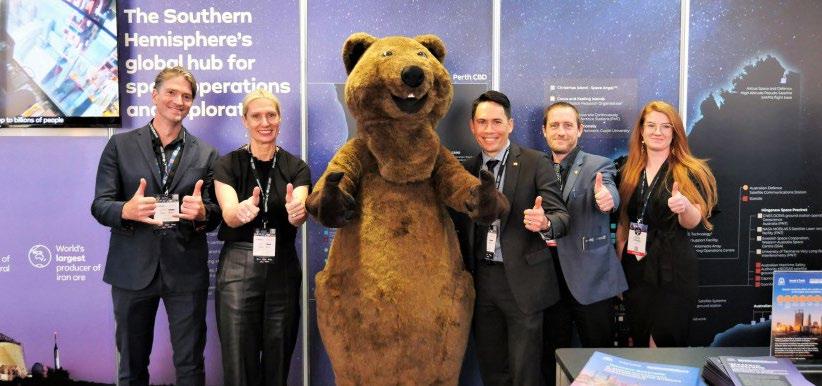
JTSI team at the 2023 Indo-Pacific Space and Earth Conference
JTSI leads the Western Australian Government’s interactions with ASA.
In July 2019, the Western Australian Government executed a Memorandum of Understanding (MoU) with ASA for the advancement and growth of the space industry sector. The MoU focuses on advancing ASA’s goal to triple the Australian space sector to $12 billion and create another 20,000 jobs by 2030.
Alongside JTSI’s representation on key ASA committees, JTSI contributes to the development of national space policies and documents, including the development of ASA’s space industry roadmaps. JTSI is also responsible for coordinating the Western Australian Government’s engagement with the European Space Agency and facilitating government to government collaboration with other international space agencies.
Additionally, JTSI is responsible for developing and implementing Western Australian Government space industry policy and advising on other policy documents that are supported by or impact the local space industry such as the Diversify WA Economic Development Framework, Future State, Investment and Trade Plan 2022-24 and WA’s 10-year Science and Technology Plan. JTSI also promotes the uptake of space technology, data and services by the defence sector through Defence West and the utilisation of locally provided EO data across government to assist with decarbonisation strategies.
JTSI also has representation on AROSE’s International Space Council to support the growth of AROSE and the local space ecosystem.
Assist development of a local highly skilled workforce to enhance space and terrestrial industry capability.
To support the growth of the Western Australian space sector there is a need to bolster and strengthen our science, technology, engineering, and mathematics (STEM) skills and ensure all Western Australians can participate in emerging opportunities. Space exploration also inspires the uptake of STEM more broadly, to support terrestrial industry capability.
The Western Australian Government’s State STEM skills strategy: Mission update 2024, sets out a cross-sectoral approach to building a globally competitive and innovative workforce, with three goals focused on preparing students with STEM skills, reskilling and upskilling the current workforce, and removing barriers for underrepresented groups. The Western Australian Government will seek to build, attract, and retain a talented space workforce to support the growth of the space ecosystem and bolster the State's global competitiveness and resilience in innovation, science, and technology. The Western Australian Government will align space workforce development activity with national strategies and priorities.
Additionally, the Western Australian Government will promote the importance of space and local space industry job opportunities.
The Western Australian Government supports initiatives which aim to grow the space workforce across different education and training levels. This includes space exhibits and exhibitions at Scitech and the Western Australian Museum across the State, and activities at the Gravity Discovery Centre, Perth Observatory and newly established Space Science Education Centre at Joseph Banks Secondary College.
Curtin University and UWA offer dedicated undergraduate space courses and research training for graduates and post-graduates, including the Binar CubeSat Space Program and TeraNet, while programs like Curtin University’s BinarX and UWA’s Space Boot Camp provide space-linked experiences for school students. Additionally, space workforce skills - such as engineering, programming, cyber security, data science and robotics - are transferable to other sectors like resources, defence, and agriculture and can offer direct benefits, especially in fields including robotics, automation, AI, remote operations, and decarbonisation.

Subject: Binar CubeSats 2, 3 and 4 released from the International Space Station Credit: JAXA
Curtin University’s Binar CubeSat Space Program (Binar Program) is Australia’s most advanced university spacecraft R&D program. Since 2021, the Western Australian Government has supported the Binar Program’s operations and outreach activities, with Western Australia’s first satellite, Binar-1, launched into space in August 2021.
The Binar Program has trained numerous postgraduates and dozens of undergraduate interns, with hundreds of university students taking part in spacecraft engineering or planetary science courses. It also includes the BinarX outreach program, training secondary school students in satellite technology. The BinarX program supports Western Australian students design and prototype science payloads that will then be incorporated and launched in a Binar CubeSat. The BinarX pilot phase involved John Curtin College of the Arts and Joseph Banks Secondary College secondary school students, with more schools joining in 2024.

Subject: US Space Surveillance Telescope at Harold E. Holt Naval Communications Station in Exmouth Credit: Commonwealth of Australia, Department of Defence Department
This Strategy will complement a range of other Western Australian Government strategies and plans. As part of the contribution to the State’s economic development framework, Diversify WA and Future State’s efforts in relation to growing the space industry sector will be closely monitored.
It is crucial that a robust framework for measuring success is established. This is to enable continuous improvement, as well as provide transparency and accountability around the actions developed to support this Strategy.
Our approach centres around a program logic that connects inputs, actions, outputs, outcomes and impacts to deliver the Vision (see Appendix 1) and support job creation, economic growth and diversification.
Short-term progress will be assessed against Action Plan progress. The Action Plan will be released after Strategy publication.
Strategy outcomes will be assessed against Goal progress. Outcome measures are provided (Appendix 2). JTSI will initially undertake a benchmarking project to determine baseline data for the 2023-24 financial year and continue to monitor this data during the Strategy term to enable targeting of improvements.
Contribution from all stakeholders is important to achieve the Western Australian Government’s vision for Western Australia’s space industry sector. While developing this Strategy, stakeholders were consulted and views from these consultations are reflected in the document. These contributions are enormously appreciated.
The Western Australian Government will continue to engage and build partnerships with business, governments, and researchers. JTSI will provide an annual update on the implementation of the Strategy on the Department’s website.
If you would like to find out more about Western Australia’s space ecosystem, please contact the Space Industry team at space@jtsi.wa.gov.au.
For further information related to Invest and Trade Western Australia’s Perth Hub and international trade and investment offices, please contact investandtrade@jtsi.wa.gov.au or visit www.investandtrade.wa.gov.au.

Subject: Researchers from UWA’s International Space Centre with Katherine Bennell-Pegg, the first Astronaut trained under the Australian flag.
Credit: UWA International Space Centre
Appendix 1. Program logic diagram
• Local, national and international space priorities, projects and investment
• Knowledge exchange
• Partnerships
Mission: To drive the growth of WA’s space ecosystem Vision: WA is a globally recognised Indo-Pacific space hub • Advocacy
Jobs growth and economic diversification through expansion of the space sector
• WA has a growing, vibrant and sustainable space ecosystem.
• WA space operations, exploration and technology transfer capability increases.
• WA attracts significant investment to support the space ecosystem.
• Opportunity facilitation • Commercialisation and technology transfer • Coordination and policy
• WA researchers, industries and government increase utilisation of local space services, data and technology.
• The WA space ecosystem supports STEM education, promotion and training.
• The WA community’s awareness on the value of space is enhanced.
• Skilled Workforce
Number of space organisations operating space and spacerelated services in WA.
Number of space sector workers in WA.
The number of organisations in WA’s space sector increases. The number of WA’s space sector workers increases.
Goal 1 WA has a growing, vibrant and sustainable space ecosystem.
$ value of investment in WA space operations, exploration and technology transfer projects.
$ value of investment (including leveraged) in WA space sector.
The WA space ecosystem’s capability in space operations, exploration and/or technology transfer increases.
Investment into the WA space sector increases.
Goal 2 WA space operations, exploration and technology transfer capability increases.
Goal 3 WA attracts significant investment to support the space ecosystem.
Number of organisations in WA utilising local space data, services and technology.
Number of students undertaking space-related STEM education.
More locally sourced space data, services and technology is utilised by WA researchers, government and industry.
WA STEM uptake is enhanced by space ecosystem activities.
Goal 4 WA researchers, industries and government increase utilisation of local space services, data and technology.
Goal 5 The WA space ecosystem supports STEM education, promotion and training.
% of WA people with awareness of space sector value.
Increased number of community members with awareness on the value of the space sector.
Goal 6 The WA community’s awareness on the value of space is enhanced.
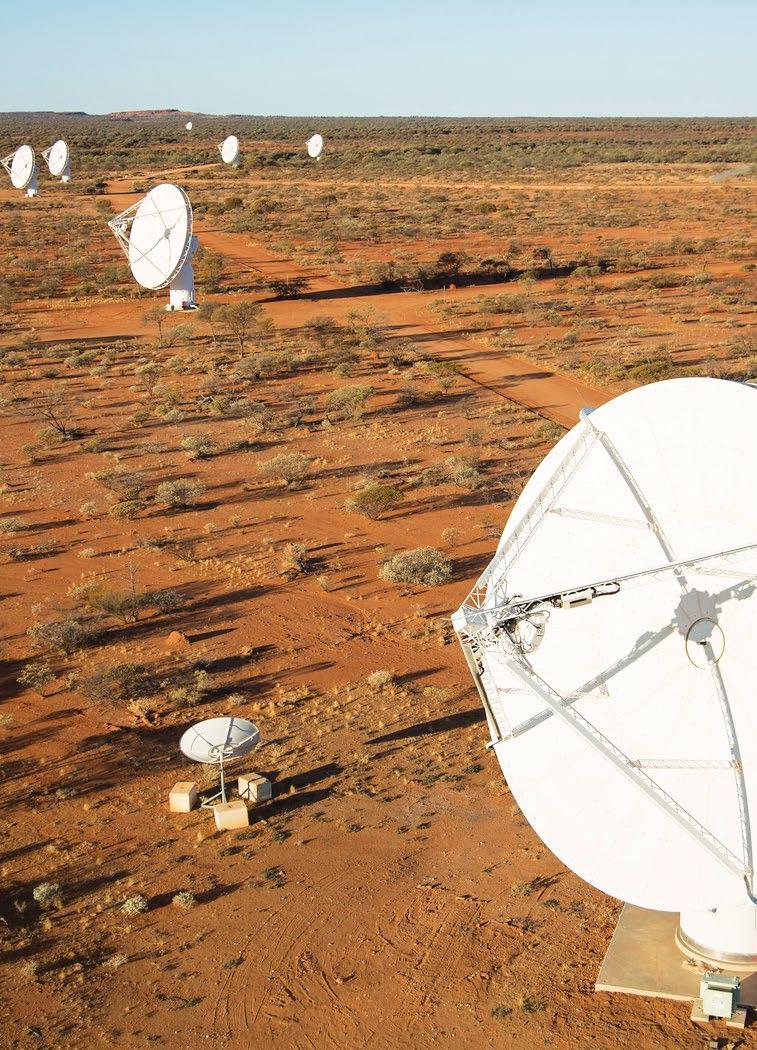
Subject: Antennae from CSIRO’s Australian Square Kilometre Array Pathfinder (ASKAP)
Credit: CSIRO